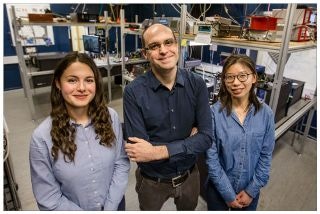Apr 24 2019
Scientists at the University of Copenhagen have created a nanocomponent that produces light particles carrying quantum information. Measuring less than one-tenth the width of a human hair, the tiny component makes it possible to expand and could eventually attain the capabilities essential for a quantum computer or quantum internet. The study result places Denmark at the forefront of the pack in the quantum race.
 The research team: Camille Papon, Leonardo Midolo and Xiaoyan Zhou from the Niels Bohr Institute. (Photo credit: Ola J. Joensen)
The research team: Camille Papon, Leonardo Midolo and Xiaoyan Zhou from the Niels Bohr Institute. (Photo credit: Ola J. Joensen)
Teams worldwide are working to design quantum technologies. The aim of the scientists based at the Center for Hybrid Quantum Networks (Hy-Q) at the University of Copenhagen’s Niels Bohr Institute is on creating quantum communication technology based on light circuits, called nanophotonic circuits. The UCPH scientists have currently realized a key advancement.
"It is a truly major result, despite the component being so tiny," says Assistant Professor Leonardo Midolo, who has been involved in this innovation for the last five years.
The study team has invented a component, known as a nanomechanical router, which emits quantum information transported by light particles (photons) and routes them into various directions within a photonic chip. Photonic chips are similar to computer microchips – only, they use light rather than electrons. The component combines nano-opto-mechanics and quantum photonics – two fields of research that, so far, have never been merged. Most remarkable of all, is the component’s size, merely a tenth that of a human hair. It is this microscopic size that makes it so encouraging for advanced applications.
Bringing the worlds of nanomechanics and quantum photonics together is a way to scale up quantum technology. In quantum physics, it has been a challenge to scale systems. Until now, we have been able to send off individual photons. However, to do more advanced things with quantum physics, we will need to scale systems up, which is what this invention allows for. To build a quantum computer or quantum internet, you don't just need one photon at a time, you need lots of photons simultaneously that you can connect to each other.
Leonardo Midolo, Assistant Professor, Niels Bohr Institute, University of Copenhagen.
Achieving “quantum supremacy” is realistic
To make the most of quantum mechanical laws to, for instance, to construct a quantum computer or a quantum internet, a number of nanomechanical routers must be combined in the same chips. Around 50 photons are necessary to have sufficient power for attaining what is called "quantum supremacy". According to Midolo, the new nanomechanical router enables doing so a realistic goal:
"We have calculated that our nanomechanical router can already be scaled up to ten photons, and with further enhancements, it should be able to achieve the 50 photons needed to reach ‘quantum supremacy’.”
The invention is also a huge leap forward in regulating light in a chip. Current technology permits for just a few routers to be combined on a single chip because of the large device footprint. Nanomechanical routers, in contrast, are very small that several thousand can be incorporated in the same chip.
"Our component is extremely efficient. It is all about being able to emit as many photons at once, without losing any of them. No other current technique allows for this,” says Leonardo Midolo.
The research is conducted in the Quantum Photonics Group at the Niels Bohr Institute, which is a part of the newly set up Center for Hybrid Quantum Networks (Hy-Q).